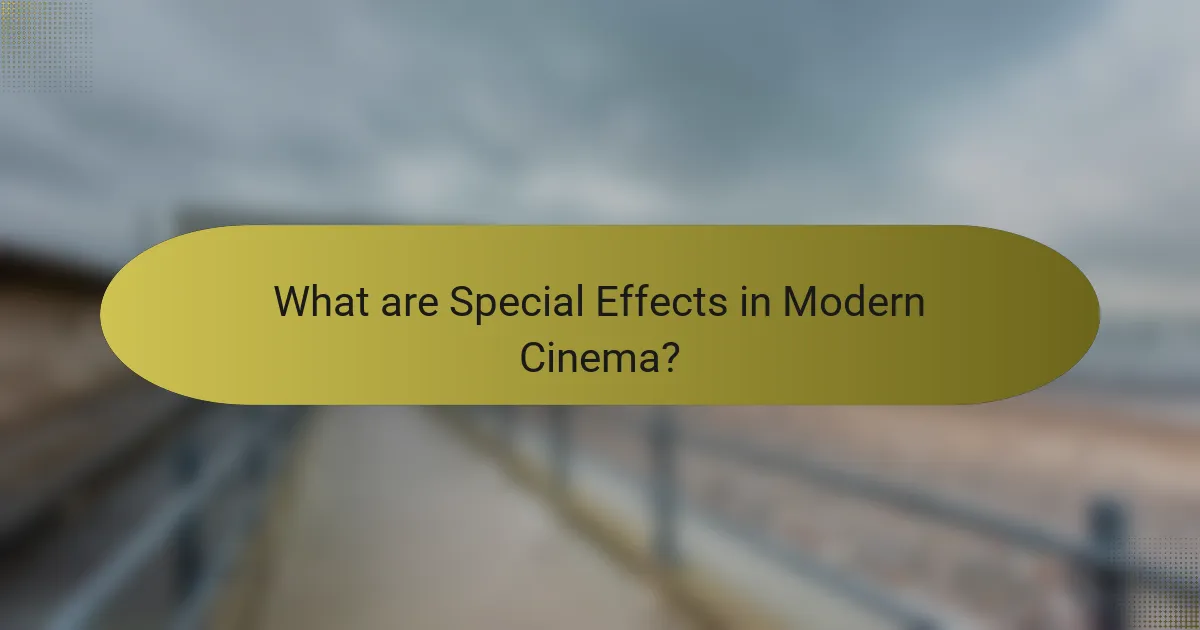Special effects are techniques used in modern cinema to create illusions and enhance visual storytelling. They encompass practical effects, such as animatronics and makeup, as well as digital effects, including computer-generated imagery (CGI). The article explores the historical context of these techniques, highlighting how practical effects dominated early cinema while digital effects gained prominence in the late 20th century. Key methods discussed include physical props, pyrotechnics, and compositing, which integrate live-action footage with digital enhancements. Notable films like “Jurassic Park” and “Avatar” exemplify the successful combination of these special effects, allowing filmmakers to create immersive experiences for audiences.

What are Special Effects in Modern Cinema?
Special effects in modern cinema are techniques used to create illusions or enhance visual storytelling. They include practical effects, such as animatronics and makeup, as well as digital effects, like CGI. Practical effects have been used since the early days of film, providing tangible elements on set. Digital effects emerged in the late 20th century, revolutionizing how filmmakers visualize complex scenes. For example, movies like “Jurassic Park” (1993) showcased groundbreaking CGI to bring dinosaurs to life. Today, special effects combine both practical and digital methods for a seamless viewer experience. This integration allows for more creative freedom and storytelling possibilities in film production.
How do special effects enhance storytelling in films?
Special effects enhance storytelling in films by creating immersive visual experiences. They allow filmmakers to depict scenes that are impossible to capture through traditional filming methods. For instance, special effects can bring fantastical elements to life, such as dragons or alien worlds. This visual enhancement engages audiences and helps convey emotions more effectively. Special effects also support narrative pacing by intensifying action sequences or dramatic moments. According to a study by the Visual Effects Society, films with high-quality special effects often achieve greater box office success. This correlation underscores their importance in modern storytelling.
What are the different types of special effects used in cinema?
The different types of special effects used in cinema include practical effects, visual effects, and sound effects. Practical effects involve physical elements created on set, such as animatronics or pyrotechnics. Visual effects, often referred to as VFX, are digitally created images added in post-production. Sound effects enhance the auditory experience through recorded or synthesized sounds. Each type serves a unique purpose in storytelling. For instance, practical effects can provide realism, while visual effects can create fantastical elements that are impossible to film in reality. Sound effects contribute to the overall atmosphere and immersion of the film. These techniques have evolved significantly, with advancements in technology enhancing their application in modern cinema.
How do special effects impact audience engagement?
Special effects significantly enhance audience engagement by creating immersive experiences. They capture attention and evoke emotional responses. Research shows that films with advanced special effects often see higher box office revenues. For example, movies like “Avatar” and “Jurassic Park” utilized groundbreaking effects that drew large audiences. These effects can also increase viewer retention, as audiences are more likely to remember visually stunning scenes. Studies indicate that 70% of viewers prefer films that utilize special effects effectively. Overall, special effects play a crucial role in making cinematic experiences more captivating and memorable.
Why are special effects important in contemporary filmmaking?
Special effects are crucial in contemporary filmmaking because they enhance storytelling and visual engagement. They allow filmmakers to create immersive worlds that would be impossible to capture through traditional methods. For instance, movies like “Avatar” and “Inception” utilize advanced CGI to depict fantastical environments and complex action sequences. This technology has transformed audience expectations, making high-quality visuals a standard requirement. Additionally, special effects can convey emotions and themes more powerfully than dialogue alone. The integration of practical effects with digital enhancements can also provide a sense of realism. According to a study by the Visual Effects Society, films with high-quality visual effects tend to perform better at the box office. Thus, special effects play a vital role in attracting viewers and ensuring a film’s commercial success.
What role do special effects play in visual aesthetics?
Special effects significantly enhance visual aesthetics in cinema. They create immersive environments that captivate audiences. Special effects can evoke emotions and heighten storytelling. Techniques like CGI and practical effects add realism to fantastical elements. For example, films like “Avatar” utilize advanced CGI to create breathtaking visuals. This integration of technology and artistry transforms the viewer’s experience. Additionally, special effects can establish a film’s tone and style. Historical films often use effects to recreate specific time periods, enhancing authenticity. Overall, special effects play a crucial role in shaping the visual narrative of modern cinema.
How do special effects contribute to a film’s budget and production timeline?
Special effects significantly impact a film’s budget and production timeline. They often require substantial financial investment for technology and skilled personnel. For instance, high-quality CGI can account for 30% to 50% of a film’s total budget. This cost includes software, hardware, and labor for visual effects artists. Additionally, special effects can extend the production timeline due to complex planning and execution. Filmmakers may spend months coordinating effects with live-action scenes. The need for extensive post-production work can also delay the release date. Therefore, special effects are a crucial factor in both budgeting and scheduling a film’s production.

What are the Main Techniques Used in Special Effects?
The main techniques used in special effects include practical effects, digital effects, and compositing. Practical effects involve physical methods such as animatronics, puppetry, and pyrotechnics. These techniques create tangible elements on set, enhancing realism. Digital effects use computer-generated imagery (CGI) to create or manipulate visuals. This technique allows for the creation of complex scenes that are difficult to achieve practically. Compositing combines multiple visual elements into a single image. This technique is essential for integrating live-action footage with digital effects seamlessly. Historical context shows that practical effects were predominant in early cinema, while digital effects gained prominence in the late 20th century. Today, a combination of these techniques is often utilized to achieve the desired visual impact in modern films.
How do practical effects differ from digital effects?
Practical effects use physical methods to create visual effects on set. Examples include animatronics, makeup, and pyrotechnics. Digital effects rely on computer-generated imagery (CGI) to create visual elements in post-production. Practical effects often provide a tangible presence that actors can interact with. Digital effects can create complex scenes that are difficult or impossible to achieve practically. Practical effects can enhance realism through physical interactions. Digital effects offer greater flexibility and can be adjusted easily during editing. Both methods can be combined to enhance storytelling in film.
What are the advantages of using practical effects over digital effects?
Practical effects offer tangible realism that digital effects often lack. They provide physical interactions with actors and sets, enhancing authenticity. Practical effects can create a sense of weight and presence, making scenes more believable. Historical films like “Star Wars” and “Jurassic Park” showcase the lasting impact of practical effects. Filmmakers often find that practical effects are easier for actors to engage with. This engagement can lead to more genuine performances. Additionally, practical effects can be more cost-effective in certain scenarios, reducing reliance on expensive CGI. Overall, practical effects contribute to a more immersive viewing experience.
In what scenarios are digital effects preferred?
Digital effects are preferred in scenarios requiring complex visuals that are difficult or impossible to achieve practically. These scenarios include creating fantastical environments or creatures that do not exist in reality. For instance, films like “Avatar” utilize digital effects to create an entire alien world. Additionally, digital effects are often used for enhancing action sequences, allowing for more dynamic and visually engaging scenes. They also provide the ability to easily edit and manipulate footage in post-production. Furthermore, digital effects can be more cost-effective compared to practical effects in certain cases, such as large-scale destruction scenes. Overall, digital effects offer filmmakers greater flexibility and creative control in storytelling.
What innovations have shaped the evolution of special effects?
Innovations that have shaped the evolution of special effects include computer-generated imagery (CGI), animatronics, and motion capture technology. CGI revolutionized the film industry in the 1990s, allowing for the creation of realistic visual effects. Notable examples include “Jurassic Park” (1993), which showcased lifelike dinosaurs. Animatronics provided a tangible, physical presence in films, enhancing realism. Films like “The Terminator” (1984) utilized animatronic effects to create convincing characters. Motion capture technology further advanced special effects by capturing actors’ movements for digital characters. This technique was prominently used in “Avatar” (2009), enabling lifelike performances in animated characters. Each of these innovations has significantly contributed to the realism and creativity of modern cinema.
How has technology influenced the development of special effects?
Technology has significantly influenced the development of special effects in cinema. Advancements in computer-generated imagery (CGI) have allowed filmmakers to create realistic and imaginative visuals. For instance, the film “Jurassic Park” (1993) showcased groundbreaking CGI that transformed the portrayal of dinosaurs. Additionally, motion capture technology has improved character animation, as seen in films like “Avatar” (2009). The use of high-definition cameras has enhanced the clarity and detail of special effects. Furthermore, software advancements enable quicker rendering times, allowing for more complex scenes. Overall, technology has expanded the creative possibilities for special effects in modern cinema.
What are some groundbreaking films that showcased innovative special effects?
Groundbreaking films that showcased innovative special effects include “Star Wars” (1977). This film revolutionized visual effects with its use of miniatures and motion control photography. “Jurassic Park” (1993) set a new standard for CGI with realistic dinosaurs. “The Matrix” (1999) introduced bullet time photography, creating a unique visual experience. “Avatar” (2009) advanced 3D technology and motion capture techniques. “Inception” (2010) featured gravity-defying scenes that challenged perceptions of reality. Each of these films pushed the boundaries of what was possible in visual storytelling.

How are Special Effects Created and Implemented?
Special effects are created and implemented through a combination of practical effects and digital technology. Practical effects involve physical props, animatronics, and makeup, which are used on set to create realistic visuals. Techniques such as pyrotechnics, miniatures, and green screen are commonly employed. Digital effects, or CGI, are produced using software to manipulate images and create lifelike animations. This technology allows for complex scenes that would be impossible to film practically. The integration of both practical and digital effects enhances storytelling in modern cinema. Notable films like “Jurassic Park” and “Avatar” showcase the successful use of these techniques. These methods allow filmmakers to bring imaginative worlds and characters to life, captivating audiences worldwide.
What processes are involved in the creation of special effects?
The creation of special effects involves several key processes. These processes include pre-visualization, design, and production. Pre-visualization allows filmmakers to plan effects using storyboards or digital models. Design involves conceptualizing the effects, including choosing techniques and materials. Production encompasses the actual creation of effects, whether through practical effects, CGI, or a combination. Practical effects use physical props and models on set. CGI, or computer-generated imagery, is created using software to generate visual effects digitally. Post-production is the final stage, where effects are integrated into the film. Each step is essential for achieving the desired visual impact in cinema.
How do pre-visualization techniques aid in special effects production?
Pre-visualization techniques significantly aid in special effects production by allowing filmmakers to visualize scenes before actual filming. These techniques include storyboarding, animatics, and 3D modeling. They help in planning camera angles, timing, and visual effects integration. By providing a clear blueprint, pre-visualization reduces production costs and time. It minimizes the risk of costly mistakes during filming. Additionally, it enhances communication among the production team. According to a study by the Visual Effects Society, effective pre-visualization can increase efficiency by up to 30%. This data illustrates the tangible benefits of these techniques in modern cinema.
What are the steps from concept to execution for special effects?
The steps from concept to execution for special effects include pre-production, design, production, and post-production. In pre-production, the idea is conceptualized and storyboarded. This phase includes determining the type of effects needed. Design involves creating detailed plans and prototypes for the effects. This can include sketches, models, or digital simulations. During production, the actual filming occurs, integrating the special effects with live action. This step may involve practical effects on set or preparing for visual effects. Post-production is where the final editing happens. This includes adding digital effects and compositing them with the footage. Each step is crucial to ensure the effects are seamless and enhance the storytelling in cinema.
What challenges do filmmakers face when using special effects?
Filmmakers face several challenges when using special effects. These challenges include high costs associated with advanced technology and skilled labor. Special effects can significantly increase a film’s budget, often requiring specialized equipment and software. Time constraints also pose a challenge, as creating high-quality effects can be time-consuming. Filmmakers must balance the time needed for effects with the overall production schedule. Additionally, achieving realistic effects can be technically complex. This complexity often requires extensive planning and coordination among departments. Filmmakers also face the risk of over-reliance on effects, which can detract from storytelling. Maintaining a balance between effects and narrative is crucial for audience engagement. Lastly, technological limitations can restrict creativity. Not all desired effects may be feasible within current technological capabilities.
How do budget constraints affect the quality of special effects?
Budget constraints significantly reduce the quality of special effects. Limited financial resources restrict access to advanced technology and skilled professionals. Lower budgets often lead to reliance on cheaper, less effective techniques. This can result in subpar visual realism and overall production value. For instance, films with higher budgets can afford extensive CGI and practical effects. In contrast, lower-budget productions may resort to outdated methods or minimal effects. A study by the Visual Effects Society indicates that budget directly correlates with the complexity and quality of visual effects in films. Therefore, budget constraints can severely impact the visual storytelling capabilities of a film.
What technical difficulties can arise during the production of special effects?
Technical difficulties in the production of special effects can include issues with equipment malfunctions. Cameras may fail to capture the desired quality, affecting the final output. Software glitches can occur during the rendering process, leading to delays. Additionally, synchronization problems may arise between live-action footage and CGI elements. Lighting inconsistencies can also create challenges, impacting the realism of effects. Resource limitations, such as budget constraints, can restrict the scope of effects. Complex simulations may require extensive computational power, which can be a bottleneck. Lastly, collaboration among departments can lead to miscommunication, complicating the workflow.
What are some best practices for effectively using special effects in films?
Effective use of special effects in films enhances storytelling and visual appeal. First, integrate special effects seamlessly with live-action footage. This creates a cohesive look and feel. Second, prioritize practical effects when possible. Practical effects often yield more realistic results and can be more engaging for the audience. Third, use special effects to support the narrative rather than overshadow it. This maintains the focus on character development and plot progression. Fourth, consider the pacing of special effects. Timing is crucial for maximizing impact during key moments. Fifth, collaborate closely with the visual effects team. Clear communication ensures that the director’s vision aligns with technical execution. Lastly, test special effects during pre-production. This allows for adjustments and refinements before filming begins.
How can filmmakers balance special effects with narrative coherence?
Filmmakers can balance special effects with narrative coherence by ensuring that effects serve the story. Special effects should enhance emotional engagement and support character development. When integrated thoughtfully, they can elevate the narrative rather than distract from it. Filmmakers must prioritize the script and character arcs during the effects planning process. For instance, in “Avatar,” the visual effects were designed to complement the themes of connection and nature. This alignment helps maintain audience immersion and understanding. Effective collaboration between directors, writers, and visual effects teams is essential. Clear communication about the story’s goals can guide the use of effects. Ultimately, special effects should be a tool for storytelling, not the focal point.
What tips can enhance the integration of special effects into a film?
To enhance the integration of special effects into a film, filmmakers should prioritize seamless blending with live-action footage. This can be achieved by ensuring consistent lighting and shadows between effects and real elements. Using practical effects alongside CGI can create a more believable environment. Additionally, maintaining a coherent visual style throughout the film is crucial. This includes matching colors and textures between effects and the surrounding scene. Filmmakers should also consider the narrative context, ensuring that special effects serve the story rather than distract from it. Collaborating closely with the visual effects team during pre-production can lead to better planning and execution. Regular testing of effects in various lighting conditions helps identify potential issues early. Lastly, gathering audience feedback during test screenings can provide insights on the effectiveness of the special effects integration.
The main entity of this article is special effects in modern cinema, which encompass techniques used to create illusions and enhance visual storytelling through both practical and digital methods. The article explores the various types of special effects, including their impact on storytelling, audience engagement, and visual aesthetics. It discusses the evolution of special effects, the challenges filmmakers face, and best practices for integrating these effects into films. Key innovations and groundbreaking films that have shaped the industry are also highlighted, providing a comprehensive overview of the significance and application of special effects in contemporary filmmaking.